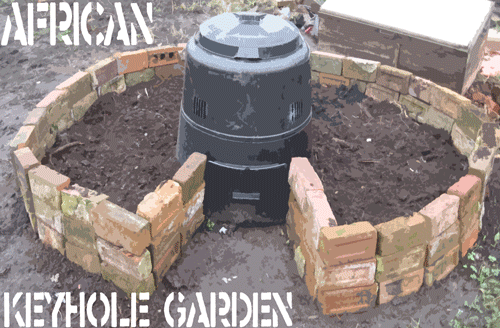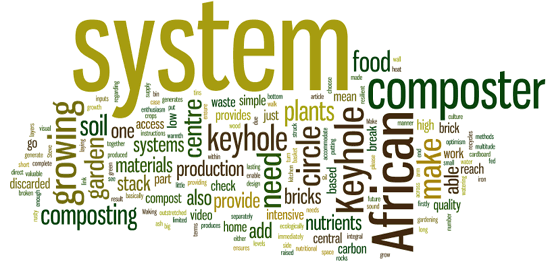When I first came across a short video of the African Keyhole garden, I was immediately struck with optimism and enthusiasm regarding their potential. This was a growing system that could be put together out of discarded materials, it was a very efficient and ecologically sound system, and it produced results.
What is an African Keyhole garden?
An African keyhole garden is basically a small scale intensive raised bed growing system that is fed through a central composting system which is made in the design of a basket to allow water and nutrients to access the soil where the plants are growing.
How do you make one?
 Making an African Keyhole garden is very simple; you will need some discarded bricks or rocks, either a compost bin, or some wire mesh to make a cylindrical composter from. Make a circle with the bricks, stack them 4 high if you are laying them in the manner of which you would when making a brick wall, or you can stack them three high if you choose to stack the bricks on their side. You need to make your brick circle big enough to accommodate a composter in the centre of the circle, and you need to ensure that your outstretched arm just is able to reach the composter in the centre; this will mean that you are able to reach all of the crops that grow in this system. You will need to make a break in the circle to enable you to walk up to the composter and access it directly, if you check the picture of my own African Keyhole system below, you will see what I mean about where the break in the circle needs to go.
Making an African Keyhole garden is very simple; you will need some discarded bricks or rocks, either a compost bin, or some wire mesh to make a cylindrical composter from. Make a circle with the bricks, stack them 4 high if you are laying them in the manner of which you would when making a brick wall, or you can stack them three high if you choose to stack the bricks on their side. You need to make your brick circle big enough to accommodate a composter in the centre of the circle, and you need to ensure that your outstretched arm just is able to reach the composter in the centre; this will mean that you are able to reach all of the crops that grow in this system. You will need to make a break in the circle to enable you to walk up to the composter and access it directly, if you check the picture of my own African Keyhole system below, you will see what I mean about where the break in the circle needs to go.
If the soil that you are putting your African keyhole system onto is of very poor quality then you will need to add more than just compost. In Africa where some of the soil is of very low nutritional quality they add a few rusty broken up tins at the bottom of the keyhole system to provide iron for the plants, they also add wood ash to provide potassium for their growing system and layers of carbon based materials such as cardboard and paper and green waste. please check the video link out at the end of this article for complete visual instructions on how to make one.
How do African Keyhole systems work?
 The composter in the centre of the keyhole system provides a number of important inputs for the system, firstly it provides nutrients from the materials that are composting in the centre of the system, and as a result of watering the system through the composter this ensures that more valuable minerals and nutrients go from the composter through to the plants that live in the system. The central composter also generates heat which in turn warms the soil up in the system which aids the growth of the plants.
The composter in the centre of the keyhole system provides a number of important inputs for the system, firstly it provides nutrients from the materials that are composting in the centre of the system, and as a result of watering the system through the composter this ensures that more valuable minerals and nutrients go from the composter through to the plants that live in the system. The central composter also generates heat which in turn warms the soil up in the system which aids the growth of the plants.
For a permanent culture
African keyhole growing systems would be an integral part of providing a resilient and long lasting food supply in a future with little or no oil. These systems also provide intensive low carbon local food production within a limited space due to the levels of warmth and fertility that they are able to generate. In terms of a home based food production system that recycles kitchen waste, the African Keyhole system is the most simple and direct way of combining the two, as this system does not work by composting separately as is the case with conventional gardening and home food production methods, the composting and growing a part of one interactive system that produces a multitude of benefits.
Steve


hi
you are the first one I see using a compost bin in a keyhole garden.
how do the nutrients get into the soil???? Did you drill holes???
Thanks
Bob
While compost in the center is a good idea, the traditional keyhole system from the Permaculture Design Manual may be preferable. It keeps the center clear so that the gardener can more easily access the entire garden from the center and doesn’t have to walk around the perimeter. This makes it especially easy to access multiple keyhole gardens in a mandala system and so requires less work of the gardener. As far as nutrients and warmth go, Bill M emphasizes that mulch is far more beneficial for plants than compost (compost is better for starting seedlings). Just spread the decaying organic matter on top of the beds as mulch instead of in the center.
I really enjoyed the notes and enabled me understanding the objectives of the Keyhole Garden and its contribution to the distribution of vegetables. So, I kindly request you to provide more materials to improve our learning careers
I have just made two beds. I didn’t want to use stone so used pallets and old floorboards – all from skips – instead.
I already had two green cones http://www.foodwasteeater.co.uk/our-products/green-cone.html?gclid=CKvrv8PDorkCFUbHtAodl3IAtw#.Uh8tR7xI2R5 so used these in the centre of the beds. I don’t have a source of free or cheap manure but the green cone will digest almost anything organic, weeds are easily disposed of as is kitchen waste.
It took about an hour to make the bed, pics attached. The pallets slot easily into a hexagonal shape about 2m diameter, some were cut in half to make the bed about 80cm high. I am now filling the bed with soil, manure, leaves, etc. Feels quite sturdy but if necessary will be reinforced with more scrap timber. I am in Bristol and will send pictures if wanted.